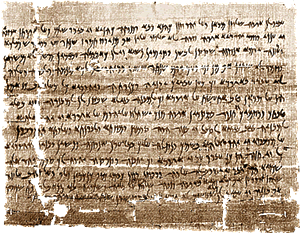Elephantine
 |
ELEPHANTINE PAPYRI - Aramaic documents of the 5th cent. BC found on Elephantine Island opposite Assuan (see SEVENEH). The publication of a first group of these texts by A. H. Sayce and A. E. Cowley in 1906 was an event in OT and Semitic studies. The texts have a great importance for the period of Ezra and Nehemiah. They revealed the existence of a military colony containing many Jews and provided with a temple of the god Yahweh (written Yhw, and pronounced Yahu or Yaho). The texts were of a legal nature, but a Berlin Museum expedition under O. Rubensohn, which dug on the island, recovered other kinds of papyri. The publication of these finds by E. Sachau (in final and complete form in 1911) greatly enriched the picture of the life of the colony and above all shed light on the history of the Yahu temple. The prize piece was the letter of the Jews of Elephantine to Bagoas, governor of Judaea (Yehud), appealing for his aid in obtaining a restoration of the temple of Yahu which had been destroyed in 410 BC at the instigation of the priests of Khnum, ram-headed patron divinity of Elephantine. Mention is made of Sanballat (q.v.) and the high priest Johanan (Neh.12.22). Brief but significant is the papyrus instructing the Jewish messenger to convey to Arsames, the satrap of Egypt, the recommendation of Bagoas and a son of Sanballat that the temple should be rebuilt. Other documents of prime importance were: a letter ordering the Jews in the name of Darius II. to celebrate the feast of Unleavened Bread in 419 BC and perhaps reflecting the first introduction of that festival among the Jews; a list of temple-contributors, showing that the treasurer not only handled funds for the god Yahu but also for the deities hshem-bethel and Anathbethel (called Anathyahu in another text); part of an Aramaic version of the Behistun inscription of Darius I; and portions of an Aramaic book of Ahikar (q.v.). After all these texts had been thoroughly discussed by scholars, A. E. Cowley published an invaluable handbook of them in 1923. Recently the Elephantine repertoire has been augmented by the surprising turning up of what must be regarded as the first find of all - a body of texts acquired in 1893 by the American Egyptologist Charles Edwin Wilbour. Indeed, it appears likely that Sayce got on the track of the 'Assuan Papyri' through Wilbour, who had shown him some fragments he had acquired. The new texts were published by the Brooklyn Museum. They are largely the family archive of a man who had some kind of a position at the Yahu temple, Ananiah bar Azariah, and contain some texts of significance for ancient law - notably with respect to slavery. A number of the texts date from the time of Artaxerxes II. The latter is in no way differentiated from Artaxerxes I and this is of interest in connexion with the dating of Ezra (q.v.). The new papyri show that the Elephantine temple must have been restored, and further that Persian sovereignty was still recognized on the island as late as the end of 402 BC. Pharaoh Amyrtaeus thus did not gain control until the spring of 401 BC - the time of the Anabasis of Cyrus the Younger. A document dated under Amyrtaeus was published by Sachau. One of the Brooklyn texts mentions the end of Amyrtaeus' reign and the accession of Nepherites I (399-393 BC). This Pharaoh probably terminated the existence of the Jewish temple and of the Jewish element in the colony. The Elephantine papyri are supplemented by numerous ostraca, a corpus of which is to be published by A. Dupont-Sommer, and by the Aramaic Leather Documents acquired by L. Borchardt and published in 1954 by G. R. Driver. These are from the archives of Nehti-Hur, major domo of the satrap Arsames.
The Jewish temple, according to the Bagoas letter, existed already when Cambyses invaded Egypt (525 BC). The oldest dated papyrus is from 495 BC. Some have argued that the Jews of Elephantine were sent down from Judah in the 7th cent., or were from Israelite territory. That the kings of Judah sent mercenaries down to Egypt is revealed by Dt.17.16. But it seems more likely that the Elephantine colony was established under Pharaoh Amasis (569-526 BC).
See E. G. Kraeling, The Brooklyn Museum Aramaic Papyri, 1953, pp. 3-119.
[Article: Dictionary of the Bible, J.Hastings, 2nd Ed., T&T.Clark, 1963 - E.G.K.]